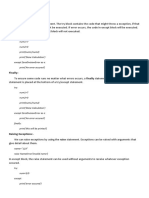0% found this document useful (0 votes)
7 views3 pagesMost Asked Python Questions
The document outlines commonly asked Python interview questions across various levels, including basic, intermediate, and advanced topics. Key features of Python, data types, memory management, object-oriented programming principles, exception handling, file handling, and common coding challenges are discussed. It serves as a comprehensive guide for preparing for Python-related interviews.
Uploaded by
Aditya KatkhedeCopyright
© © All Rights Reserved
We take content rights seriously. If you suspect this is your content, claim it here.
Available Formats
Download as PDF, TXT or read online on Scribd
0% found this document useful (0 votes)
7 views3 pagesMost Asked Python Questions
The document outlines commonly asked Python interview questions across various levels, including basic, intermediate, and advanced topics. Key features of Python, data types, memory management, object-oriented programming principles, exception handling, file handling, and common coding challenges are discussed. It serves as a comprehensive guide for preparing for Python-related interviews.
Uploaded by
Aditya KatkhedeCopyright
© © All Rights Reserved
We take content rights seriously. If you suspect this is your content, claim it here.
Available Formats
Download as PDF, TXT or read online on Scribd
/ 3






















































